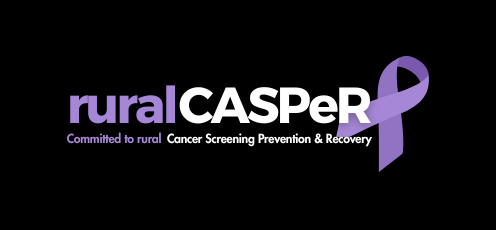
ruralCASPeR
Mission

This group is organized for the express purpose of developing and pursuing a collaborative and complementary program of research exploring cancer disparities as they are experienced in rural areas. The research is intended to be grounded in the patient perspective and experience, and can encompass aspects of cancer risk, prevention, screening, diagnosis, treatment, and care. The cancer experience is also considered to include all those impacted, such as caregivers, family and friends, payers and providers. Consideration of rural cancer through an equity lens will ensure that existing disparities are not further exacerbated, but examined in this context.
Background + Goals
Research into cancer epidemiology and rural disparities began with this group in 2012 with a grant from the American Cancer Society – Illinois Division. Led by Dr. Steward, this developed a collaboration in southern IL to address lung cancer disparities. This work led in part to a collaboration with Siteman Cancer Center at Washington University at St. Louis on a 2015 P20 NIH/NCI grant to address rural cancer disparities (led by Drs. Colditz and Brard). Other work over the years has examined the epidemiology of tobacco products use (e.g., vaps vs cigarettes), genomic diversity in rural communities, and spatial analysis of cancer risk and environmental exposure.
ruralCASPeR seeks to consolidate these past experiences and collaborations into a forward-leaning Program of research and engagement. Our team has a diverse set of skills, experiences, and interests and are working to develop and implement research and programs that are of high impact and important to our partners and region. We also seek to leverage other complementary partnerships and experiences, and this is evidenced by current work addressing cervical cancer screening disparities among LGBTQ+ individuals residing in (largely rural) central and southern IL. With our community advisory board, academic and healthcare partners, and agency representatives we continue to research and promote cancer prevention, screening and recovery in Illinois.
Community Advisory Board
Board membership in progress. Please check back soon for updates.
i. Engaging rural lesbian, transgender, and bisexual individuals in cervical cancer screening (E-Resilience); Simmons Cancer Institute – Team Science Grant (1 Jul 2023-30 Jun 2025)
- Investigators: WD Jenkins, P Bhandari, MJ Lee, KW Miller
- Specific Aims/Summary
Currently in development. Please check back soon for updates.
i. Engaging rural lesbian, transgender, and bisexual individuals in cervical cancer screening (E-Resilience) – R15 to NIH NCI Feb 2023
- Investigators: WD Jenkins, MJ Lee, KW Miller, R Bolinski, P Bhandari
- Specific Aims/Summary
ii. MJL HPV vaccination R15
i. Cancer Screening Outreach to Rural People who use Drugs (CaSORP) – R21 to NCI in 2022
People who use drugs (PWUD) frequently experience stigma in healthcare venues – to the point that many no longer seek routine primary care but only attend urgent/emergency care when in need. Our preliminary data show that rates of preventive cancer screening, already lower in rural (versus urban) area, is even lower among rural PWUD. We’re interested in exploring how a community-based harm reduction provider may collaborate with a healthcare system and peer navigators to better engage rural PWUD in routine care to increase screening utilization.
i. Adaptation of Robotic Colon and Rectal Surgery: Assessment of Clinical and Financial Outcomes;
Memorial Medical Center Foundation (7/1/19-9/30/20)
ii. Addressing Rural Cancer Disparities Health Disparities: An SCC-SIUSM Partnership;
NIH/NCI (9/1/15-8/31/18; 1P20CA192987-[01A1-03])
iii. Illinois Department of Public Health); Illinois Comprehensive Cancer Control State Cancer Plan;
Centers for Disease Control and Prevention (1/1/16-12/31/16; #73204001E and #63204001D)
iv. Exploration of Genomic Diversity across Rural Illinois Communities;
Southern Illinois University School of Medicine/University of Illinois Urbana/Champaign (8/1/15-7/31/16)
v. Addressing Rural Cancer Disparities: Understanding Smokeless Tobacco Use in Rural Illinois;
Illinois Department of Public Health (3/14-3/15)
vi. Geospatial Analysis of Potential Environmental Causes of Cancer in Illinois;
Caryl Towsley Moy, PhD, Endowed Fund for Collaborative Research (3/1/14-12/31/14; MEF #2014-2)
vii. Proposal to Characterize Cancer Patient and Family Literacy;
Memorial Medical Center Foundation (3/13-4/14)
viii. Collaboration to Reduce Lung Cancer Disparities in the Southern IL Delta Region;
American Cancer Society – Illinois Division (2/12-1/14)
Notable
i. Zahnd WE, James AS, Jenkins WD, Izadi SR, Fogleman AJ, Steward DE, Colditz DA, Brard L. Rural-Urban Differences in Cancer Incidence and Trends in the United States. Cancer Epidemiol Biomarkers Prev. 2017 Jul 27. pii: cebp.0430.2017.
ii. Jenkins WD, Rose J, Molina Y, Lee M, Bolinski R, Luckey G, Van Ham B. Cancer Screening among Rural People Who Use Drugs: Colliding Risks and Barriers. Int J Environ Res Public Health. 2022 Apr 10;19(8):4555.
iii. Lee M, Jenkins WD, Adjei Boakye E. Cancer screening utilization by residence and sexual orientation. Cancer Causes Control. 2020 Oct;31(10):951-964.
Past Year
None
Hotlinked
None
For a full list of publications, click here.
Notable
None
Past Year
None
Hotlinked
i. Jenkins WD, Lee M, Miller K, Thompson T, Elgee M, Spenner A. Cancer risk, screening and healthcare engagement among rural LGBTQ+ individuals: preliminary data and opportunities. Presented at: Addressing Policy and Structural Barriers to Improve Rural Cancer Health Conference (NIH-sponsored); 11-12 Aug 2022; St. Louis, MO.
ii. Adjei Boakye E, Wang M, Jenkins WD, Osazuwa-Peters N, Babatunde O, Lee MJ, Kim M. Geographic variation in human papillomavirus (HPV) vaccination initiation and completion among adults in the United States. Presented at the 12th AACR Conference on the Science of Cancer Health Disparities in Racial/Ethnic Minorities and the Medically Underserved, San Francisco, CA.
iii. Lee M, Jenkins WD, Adjei Boakye E. Cancer screening disparities among rural sexual minority individuals: implication for prevention and policy. 12th AACR Conference on The Science of Cancer Health Disparities in Racial/Ethnic Minorities and the Medically Underserved, San Francisco, CA, USA, September 20-23, 2019.
iv. Adjei Boakye E, Jenkins WD, Osazuwa-Peters N, Wang M, Lee MJ, Chen B, Agamah ES, Sharma A. Incidence of second primary neoplasms among cancer survivors in the United States, 2000 through 2015. Presentation at: 2019 American Society for Clinical Oncology (ASCO) Annual Meeting; 2-4 June 2019; Chicago, IL.
v. Slomer L, Adjei Boakye E, Emuze D, Lee MJ, Brown R, Jenkins WD. Perceptions of harm for alternative tobacco products versus cigarette smoking. Presented at the American Public Health Association annual meeting; Philadelphia, PA; 2-6 Nov 2019.
For a full list of presentations, click here.
i. Jenkins WD, Choudhary V, Fogleman A, Miller KW, Bhandari P, Lee MJ. Disparities in cervical cancer screening among rural LGBTQ+ individuals. SIUSOM-PSP Policy Series. 2024 (1);1-10.






